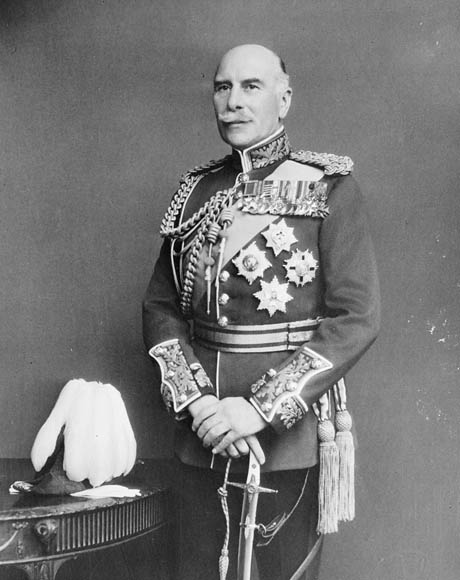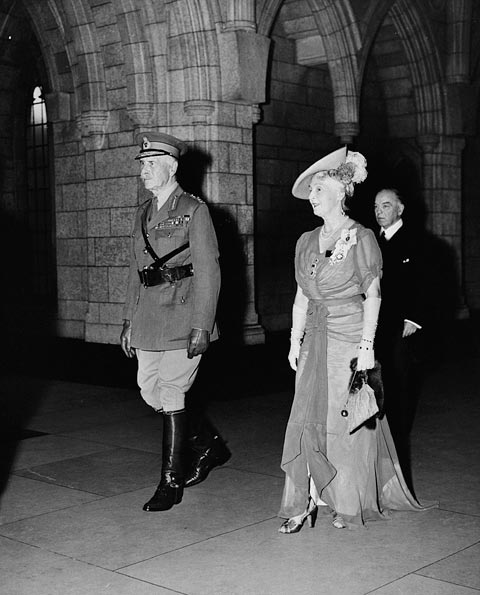by Susan Flantzer © Unofficial Royalty 2015

Alexander Cambridge, 1st Earl of Athlone; Credit – Wikipedia
The husband of Queen Victoria’s granddaughter Princess Alice of Albany, and Governor-General of both the Union of South Africa and Canada, His Serene Highness Prince Alexander of Teck was born in Kensington Palace in London, England on April 14, 1874. He was the fourth child and third son of Prince Francis, Duke of Teck, and Princess Mary Adelaide of Cambridge. His mother was a male-line granddaughter of King George III and a first cousin of Queen Victoria. Princess Mary Adelaide weighed approximately 250 pounds and was affectionately known as “Fat Mary.” Queen Victoria wrote of her, “Her size is fearful. It is really a misfortune.” Princess Mary Adelaide, however, was high-spirited and full of life, and was adored by the Victorian public who called her “The People’s Princess.”
Alexander’s father was His Serene Highness Prince Francis of Teck, the product of a morganatic marriage. Prince Francis’ father, Duke Alexander of Württemberg, was once heir to the throne of Württemberg. However, Duke Alexander contracted a morganatic marriage (marriage to a person of a lower rank) to a Hungarian countess, Claudine Rhedey. Duke Alexander lost his rights to the throne and his children lost the right to use the Württemberg name. Francis’ cousin King Karl of Württemberg eventually elevated him to the more important Germanic title of Duke of Teck.
Mary Adelaide and Francis had a happy marriage but had chronic financial problems due to Mary Adelaide’s extravagance and generosity. Queen Victoria gave them an apartment at Kensington Palace where their four children were born. Christened Alexander Augustus Frederick William Alfred George, Alexander was called Alge, a name derived from the first two letters of Alexander and George. He had an older sister and two older brothers:
- Princess Victoria Mary of Teck (May) (1867 – 1953) later Queen Mary, married King George V of the United Kingdom, had issue
- Prince Adolphus of Teck (Dolly) (1868 – 1927), later Duke of Teck and 1st Marquess of Cambridge, married Lady Margaret Evelyn Grosvenor, had issue
- Prince Francis of Teck (Frank) (1870 – 1910), unmarried

Queen Mary with her mother and brothers by Alexander Bassano, half-plate glass negative, circa 1884 NPG x96004 © National Portrait Gallery, London
Alge was first educated at home by tutors and at a local morning school. All the Teck children were encouraged to learn languages, and their parents insisted they speak only French at some meals and only German at others. In 1883, when Alge was nine years old, his parents were forced to flee the country due to their financial situation. The family settled in a villa in Florence, Italy where they lived more cheaply for two years. Alge’s two elder brothers remained in England, attending boarding school. During this time, Alge and his sister May developed a close relationship that was to last all their lives.
The family returned to England in the spring of 1883 and Alge was enrolled in Reverand A.H. Morton’s boarding school in Farnborough, England. At the beginning of the Lent Term in 1889, Alge began to attend Eton College. In 1892, Alge started his military education at the Royal Military College, Sandhurst. Two years later, Alge was commissioned a Second Lieutenant in the 7th Hussars and stationed in India. In 1896, Alge was transferred to Africa and participated in the Second Matabele War and in the Second Boer War.
At the coronation of King Edward VII in 1902, Alge caught the eye of the King’s niece Princess Alice of Albany. Alge and his siblings had known Alice since childhood, although they were much older than she was. Alice was the daughter of Queen Victoria’s youngest son Prince Leopold, Duke of Albany and his wife Princess Helena of Waldeck and Pyrmont. Prince Leopold inherited hemophilia from his mother and died at age 30 from a fall that caused a cerebral hemorrhage, the injuries, having been exacerbated by his hemophilia. Alice was just 13 months old and her mother was pregnant with her brother Charles Edward, who was Duke of Albany at birth and succeeded his uncle Alfred as Duke of Saxe-Coburg-Gotha in 1900. Alice and her mother lived at Claremont and Alge was stationed at nearby Hampton Court Palace, so there was an opportunity for the couple to court. Alge and Alice became engaged on November 16, 1903.
The wedding was held on February 10, 1904, at St. George’s Chapel at Windsor Castle. After Alge’s wedding leave from the British Army, he became the aide-de-camp to Sir John French, the commander at the Aldershot Garrison. King Edward VII allowed the couple to live at the Royal Pavilion at Aldershot. Toward the end of 1904, Alge’s regiment was scheduled to be transferred out of the country, but King Edward VII insisted that Alge remain in England and be transferred to the Royal Horse Guards. The King also allowed his niece and her husband to live at the Henry III Tower of Windsor Castle as the Horse Guards were stationed at the Windsor Castle barracks.
Alge and Alice had three children:
- Princess May of Teck, later Lady May Cambridge (1906 – 1994), married Henry Abel Smith had issue
- Prince Rupert of Teck, later Rupert Cambridge, Viscount Trematon (1907 – 1928), unmarried, hemophiliac, died in a car crash
- Prince Maurice of Teck (born and died 1910), died in infancy

Princess Alice, Countess of Athlone with her children May and Rupert, circa 1909; Photo Credit – Wikipedia
Alice was a hemophilia carrier. Her father Prince Leopold was the only one of Queen Victoria’s four sons to have hemophilia and the first of the nine hemophiliacs among Queen Victoria’s descendants. All daughters of hemophiliacs have to be carriers because their fathers pass their X chromosome to them and it is on the X chromosome where the hemophilia gene is carried. All sons of hemophiliacs will not have the disease because they receive a Y chromosome from their father. Alice’s son Rupert was a hemophiliac. On April 15, 1928, 20-year-old Rupert died from an injury received in a car accident which he probably would have recovered from had he not been a hemophiliac. It is also possible that Alge and Alice’s son Maurice, who died at the age of six months, was a hemophiliac.

Prince Alexander of Teck, 28 June 1910; Credit – Wikipedia
During World War I, Alge saw active service in Belgium and France. Due to anti-German sentiment during World War I, King George V issued Letters Patents on July 17, 1917 “declaring that the name Windsor is to be borne by his royal house and family and relinquishing the use of all German titles and dignities.” Alge relinquished the title Prince of Teck in the Kingdom of Württemberg and the style Serene Highness. His two surviving children also lost their Württemberg titles and styles. The Teck family adopted the surname Cambridge (Alge’s eldest brother Adolphus became the 1st Marquess of Cambridge) and for several months Alge’s style was Sir Alexander Cambridge. On November 7, 1917, King George V created him Earl of Athlone and Viscount Trematon. Alge’s son Rupert used his father’s secondary title as a courtesy title and his daughter May was styled Lady May Cambridge. Alice was then styled Her Royal Highness Princess Alice, Countess of Athlone.
At the end of World War I, Alge retired from the army and took up civilian work including continuing as Chairman of Middlesex Hospital in London, a post he was first appointed to in 1910. From 1924-1930, Alge was the Governor-General of South Africa and he was the Governor-General of Canada from 1940-1946. During the World War II years in Canada, Alge and Alice welcomed a number of displaced royals who had sought refuge in Canada: Crown Prince Olav and Crown Princess Märtha of Norway; Grand Duchess Charlotte and Prince Felix of Luxembourg; King Peter of Yugoslavia; King George of Greece; Empress Zita of Austria and her daughters; as well as Alice’s first cousin Queen Wilhelmina of the Netherlands and her daughter, Princess Juliana.

The Earl of Athlone and Princess Alice, Countess of Athlone at the Opening of Parliament in 1946; Photo: Wikipedia
In 1946, Alge retired and he and Alice took a grace and favor apartment at Kensington Palace in London. However, Alge did not completely retire. He served on the committee organizing the 1953 coronation of his great-niece Queen Elizabeth II and continued to serve as Chancellor of the University of London until 1955. Alge died on January 16, 1957, at Kensington Palace in London, England at the age of 82. After a funeral with full military honors, Alge was buried at the Royal Burial Grounds at Frogmore in Windsor, England. Alice survived Alge by 24 years, dying on January 3, 1981, one month short of her 98th birthday, the last surviving grandchild of Queen Victoria, and the longest-lived person of the Blood Royal of the British Royal Family. Alice was buried beside her husband and son Rupert at the Royal Burial Grounds at Frogmore in Windsor, England.
This article is the intellectual property of Unofficial Royalty and is NOT TO BE COPIED, EDITED, OR POSTED IN ANY FORM ON ANOTHER WEBSITE under any circumstances. It is permissible to use a link that directs to Unofficial Royalty.
